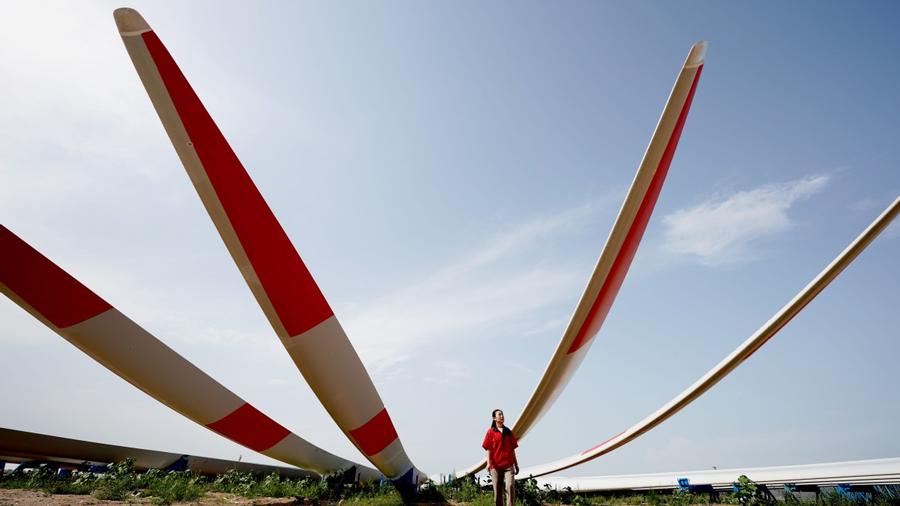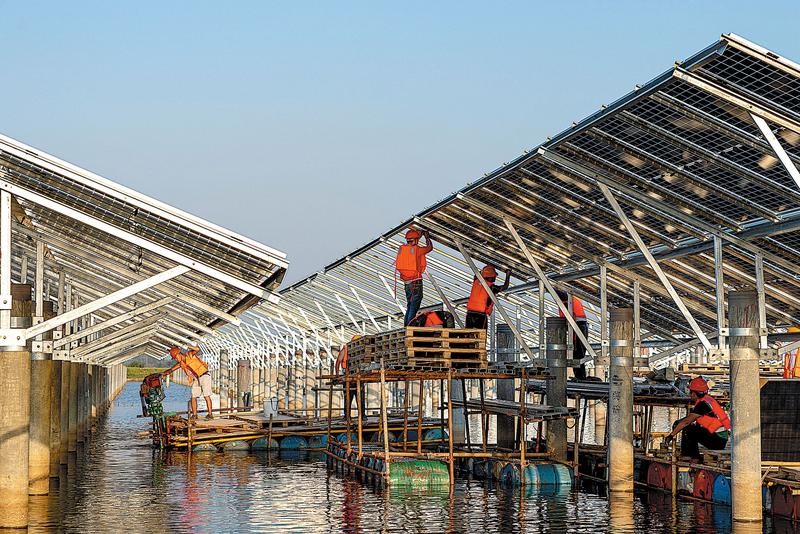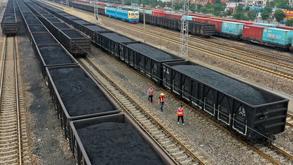 In this undated file photo, a technician checks wind turbine blades at a plant in Weixian county, Hebei province. (PHOTO / XINHUA)
In this undated file photo, a technician checks wind turbine blades at a plant in Weixian county, Hebei province. (PHOTO / XINHUA)
China's pledge to achieve carbon neutrality only 30 years after peaking carbon dioxide emissions will require it makes a lot more arduous efforts than developed economies in this regard, experts said.
With a large economy, the nation will have to bear a huge cost for such a rapid low-carbon transition. Many unpredictable costs in the process will just add more difficulties, but China will eventually find solutions to these issues, as it has done in the past, they said.
While rapid technological upgrading is needed to facilitate the quick transition, the experts said emerging new technologies may pose new challenges to many enterprises' investment in research and development.
President Xi Jinping announced in an address via video link to the United Nations General Assembly on Sept 22 last year that China aims to peak carbon dioxide emissions before 2030 and achieve carbon neutrality before 2060.
Xie Zhenhua, China's special envoy for climate change affairs, said that as a developing nation, China has an industrial structure that remains dominated by heavy industry and its energy mix still relies on coal. This means that the country's low-carbon transition will not come easy
While addressing the Leaders Summit on Climate on April 22, which was hosted by the United States, Xi said the decision on the targets was made based on China's sense of responsibility to build a community with a shared future for mankind and its own need to secure sustainable development.
"China has committed to move from carbon peak to carbon neutrality in a much shorter time span than what it might take many developed countries, and that requires extraordinarily hard efforts," he said.
Wang Jinnan, head of the Chinese Academy of Environmental Planning, said China must act with urgency to overcome burdensome tasks and difficult challenges in achieving its climate targets.
The nation's growing energy demand as it endeavors to realize socialist modernization by 2035 will put formidable pressure on the country's goal of peaking carbon dioxide emissions, said Wang, who is also an academician at the Chinese Academy of Engineering.
The European Union has about 70 years to go from carbon peak to neutrality, and it needs to reduce its carbon emissions by 60 million metric tons annually during this period, he said. However, China has to annually reduce its emissions by at least 300 million tons from 2030 to 2060.
ALSO READ: Companies gearing up to reduce CO2 emissions
Xie Zhenhua, China's special envoy for climate change affairs, said that as a developing nation, China has an industrial structure that remains dominated by heavy industry and its energy mix still relies on coal. This means that the country's low-carbon transition will not come easy.
But he said many opportunities will also emerge from this transition.
 In this undated file photo, workers install solar panels at a reservoir in Feidong county, Hefei city, Anhui province. (RUAN XUEFENG / FOR CHINA DAILY)
In this undated file photo, workers install solar panels at a reservoir in Feidong county, Hefei city, Anhui province. (RUAN XUEFENG / FOR CHINA DAILY)
In the energy system's low-carbon transition, over 130 trillion yuan ($20 trillion) of investment will be leveraged if China takes proactive climate measures, which is about 2 to 3 percent of its annual GDP, he noted.
"The market potential is big," he said, adding that these low-carbon endeavors will not only promote high-quality economic development but also address environmental pollution at its root.
He said these proactive efforts are expected to bring down the average annual concentration of PM 2.5-particles of 2.5 microns or less in width that pose a health hazard-to 15 micrograms per cubic meter, creating a much healthier environment.
According to the Ministry of Ecology and Environment, in 2020, the average PM 2.5 density in the country stood at 33 mcg per cubic meter.
Liu Shangxi, head of the Chinese Academy of Fiscal Sciences, said the cost of the nation's low-carbon transition would be high for a country with such a large economy, and how to address it would be a decisive factor in how China reduces carbon emissions and pollution.
The control of carbon emissions and pollution needs policy, technology and accounting systems. The establishment of these systems all comes at a cost, he said.
ALSO READ: Massive hydropower dam to help country meet carbon neutrality goal
Liu Shangxi, head of the Chinese Academy of Fiscal Sciences, said the cost of the nation's low-carbon transition would be high for a country with such a large economy, and how to address it would be a decisive factor in how China reduces carbon emissions and pollution
High-cost era
He said China is entering a high-cost era. In addition to the burden from its aging population and the cost of its low-carbon transition, China is also confronted with costs that may emerge from uncertainties in the complex international environment and the costs generated as the world revamps its supply and industry chains.
In the current stage, he said one issue that should be fully considered is how to share these costs among the government, the market and different social sectors.
Song Lianchun, director of the National Climate Center, said that based on current technical feasibility, the potential annual capacity of solar and wind power generation across China, including offshore wind power, stands at 77.9 trillion kilowatt-hours, 11 times the country's total electricity consumption in 2019 and five times its expected power demand in 2050.
 In this undated file photo, inspectors patrol along the railway for transportation of coal in North China's Shanxi province. (PHOTO / XINHUA)
In this undated file photo, inspectors patrol along the railway for transportation of coal in North China's Shanxi province. (PHOTO / XINHUA)
Based on power generation costs equal to those of coal-fired power plants, the annual capacity of onshore wind and solar energy that could be developed with current technologies is about 10.4 billion kilowatt-hours, he said.
However, he noted that there would be challenges in utilizing these sources of power, as both are intermittent due to varying weather conditions.
But solar and wind power are mutually complementary, he said. Their intermittent problems may possibly be addressed by optimizing the distribution of power generation facilities.
Extreme weather can have a very big impact on the use of new energy. Detailed research is required to solve the problem.
Song Lianchun, director of the National Climate Center
Song also warned of the threat that extreme weather events pose to wind and solar power generation.
In mid-February, more than 4 million people were without power in the US state of Texas after a rare deep freeze. Song pointed out that the area's energy mix, with as much as 20 percent coming from wind power, was a factor contributing to the power outage.
"Extreme weather can have a very big impact on the use of new energy. Detailed research is required to solve the problem," he said. One of the solutions is to enhance power storage capacity and improve the design standards of power generation facilities.
While the cost of renewable energy generation has sharply decreased, power storage costs remain high.
READ MORE: Green finance grows to meet carbon goals
Despite these challenges, China will steadfastly forge ahead with its ambitious targets.
China always honors its commitments, as stressed by President Xi while addressing the Leaders Summit on Climate.
"Guided by our new development philosophy, we will promote greener economic and social development in all respects while pursuing high-quality development," he said.
"We will take solid steps to implement the targets just announced, and contribute even more to tackling the global climate challenge."


